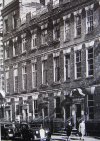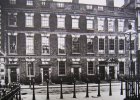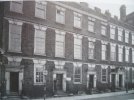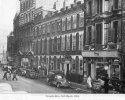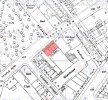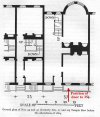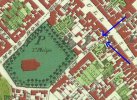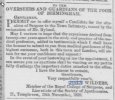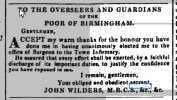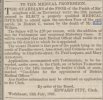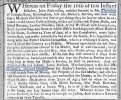No 37. (formerly no 20) Temple Row
One of the earliest occupants (or possibly the first) was Walter Tippin, who, in partnership with his son Thomas, was a merchant with a warehouse behind his house, entered from the Cherry Orchard . The map below shows the area in 1731. I am not clear if the Cherry Orchard extended over the whole area of trees shown. If so then probably the warehouse was one of the two buildings marked with a blue arrow. If only the area definitely marked as a cherry orchard , then probably that marked with a purple arrow. The un-named road/track going through the trees later became Cherry St. The map has been rotated to give a view more normally now seen on maps, which means that some wording at an angle

In 1835 Walter moved to Witton Hall, and the house was taken over by his son Thomas, who later provided funding for Matthew Boulton. Thomas moved out in 1750 and died in December 1783.
In 1752 the house was taken by the, then unknown, John Ash, who at the time had not become fully qualified, but who later was well known in the area as a physician and the founder of the General Hospital. He stayed there till 1769, then moving 2 doors down to the house on the corner of Cherry St., which had, at one time been occupied by a short-term partner of the Tippins.
For a short time the house was occupied by Francis Hurd, a merchant and gunsmith, who was made bankrupt and left in 1773. His merchant activities seem to be as a draper and mercer, which is how he is described in his bankruptcy . Gunsmithing was not mentioned.
John Gimblett was the next occupant, He was the son of John Gimblett, senior, and trinket maker, who was made bankrupt his business then was purchased by his son from the assignees (sounds a bit like some of the dodgy deals done today). John partnered with a William Vale and later with William Whitmore in the business. He and Vale were one of the first businesses to register their mark with the Birmingham Assay Office in 1773.
John remained here till 1786, and in 1789 William Whateley, an attorney, moved in and remained till 1801.In 1791 he was appointed a "master extraordinary" in the High court of Chancery. He was Coroner for Warwickshire and, unsuccessfully, attempted to become Birmingham's first coroner. (
https://birminghamhistory.co.uk/forum/index.php?threads/birminghams-first-coroner.54720/#post-754023).
R & M Howell then used the house for a more commercial purpose, as a haberdashers, specialising in child bed linen, remaining there till 1805, when they moved the business to 79 Bull Street. He was followed by Thomas Baker Robinson, carver, gilder, glass grinder, polisher and picture frame maker, but he did not stay long, and by the 1815 Wrightson's directory was ensconced at the Greyhound, Bull St.
The house was briefly occupied in 1810 by Dr John Bright (not the one the Street was named after), physician to the General Hospital, but who resigned after a year in the job to go to London. The next tenant was Joshua Scholefield who was there from 1811 till 1822. At the time partner in his father-in-law's firm, Cotterill & Sons, and was High Bailiff of Birmingham. He, with Thomas Attwood, in 1832 was one of the first MPs elected for the Borough of Birmingham. a post he held till his death in 1844.
John Kaye Booth had taken over the job of physician to the General Hospital after John Bright's departure, and initially lived at 14 The Square (now Old Square). In 1822 he moved into that same house in Temple Row that had been occupied by his predecessor, and remained there till moving to Bath in 1843. In addition to his job at the hospital he was the first Lecturer in Medicine at Birmingham Medical School. William Sands Cox was the originator of the idea of a medical school, initially giving demonstrations in his father's house at 24 Temple Row and must have initiated Booth's interest. He was one of the leading promoters of public baths for the health of the inhabitants of the city, and when he left all the great and the good held a public breakfast in his honour. Certainly for a time in 1823 he ran a rope and twine business from the house.
He was succeeded by Samuel Hemming, architect, surveyor, and secretary to Guardian Society for the Protection of Trade, which was a trade association. His office was here, but he, in fact lived in Pakenham Road in Edgbaston. In 1847 Samuel was the successful architect for the Corn Exchange, off High Street and shortly after for the General Institution for the Blind in Carpenter Road. He was also highly praised for his plans in 1848 for the new Birmingham Workhouse, which were accepted by the Committee evaluating the competition and the Poor Law Commissioners, but later rejected by the Board of Guardians, a decision which caused some vocal public disagreements. In passing he was also responsible in 1852 for the renovation of St Bartholomew's Church, in which the painting was, appropriately, carried out by Mr. S. Bartholomew.
Hemming supposedly left in 1858, and certainly, by 1862 the Corporation directory y lists his offices at 58 New St. He was succeeded by Dr Alexander Fleming,, who had just been appointed Physician to the Queen's Hospital, and remained there till his death in 1875. It is around this time that the building was subdivided into 20 and 20A, and the rather flamboyant extra new entrance constructed. Dix's 1858 directory and the 1861 Corporation Directory both list both Hemming and Fleming at no 20 (in 1861 also with a firm Norton & Son), but Hemming had always only used the building as an office, so it is possible that that for a while he occupied what would be 20A in that capacity, while Fleming occupied the remainder. After Fleming's death the house became the home of solicitors Saunders & Bradbury, who, together with other soliciting firms, remained there till the building was replaced by Rackhams.
